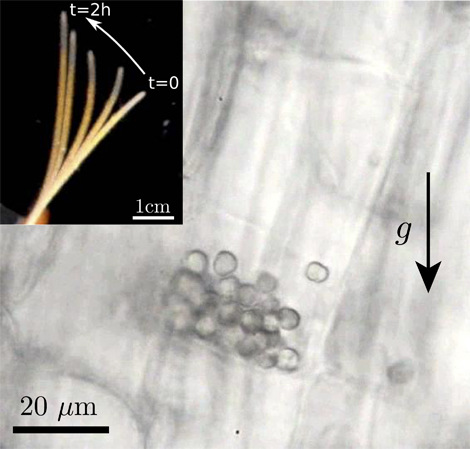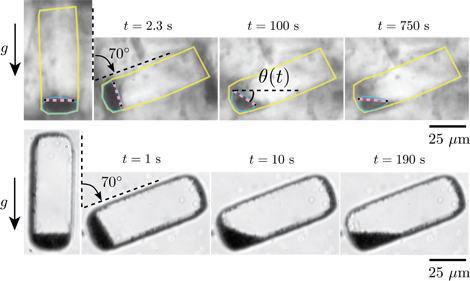Global S&T Development Trend Analysis Platform of Resources and Environment
| Why plants are so sensitive to gravity : The lowdown | |
| admin | |
| 2018-05-02 | |
| 发布年 | 2018 |
| 语种 | 英语 |
| 国家 | 法国 |
| 领域 | 地球科学 |
| 正文(英文) | Plants can detect the slightest angle of inclination. Yet the mechanism by which they sense gravity relies on microscopic grains. In theory, such a system should hardly allow for precise detection of inclination. Researchers from the CNRS, the French National Institute of Agronomic Research (INRA), and Université Clermont Auvergne have now explained this curious paradox. They observed that, within the plant cells, the grains are constantly being agitated. This endows them collectively with properties similar to those of a liquid so that they act in unison like a carpenter's level. These findings were published in PNAS April 30, 2018.
If you tilt a plant, it will alter its growth to bend back upwards. But how does it detect the inclination? With cellular clinometers: cells filled with microscopic grains of starch called statoliths. In each of these cells, the pile of statoliths settles to the bottom. This provides a point of reference to guide growthby modifying the distribution of a growth hormoneso that the plant may return to an upright position.
The mystery of plants is what makes them so extremely responsive to gravity, at even the tiniest deviation from the vertical. But a heap of grains would seem to be a lousy clinometer. Normally, friction and interparticle locking would limit the flow of the grains, making the granular system ineffective below a threshold angle of inclination. However, plant statoliths are astonishingly precise. Researchers from the Institut Universitaire des Systèmes Thermiques Industriels (CNRS/Aix-Marseille University) and the Physique et Physiologie Intégratives de l'Arbre en Environnement Fluctuant laboratory (INRA/Université Clermont Auvergne) teamed up to solve this puzzle. First, they directly observed the movement of statoliths in response to tilting, discovering they did not behave like a standard granular system. Statoliths move and flow no matter how the cell is angled. The surface of the statolith piles always settles into a horizontal plane, just like a liquid. But how do cells make these piles so fluid? To elucidate the origin of this property, the team continued their study by developing a model of plant statoliths: microbeads in artificial cells sized like real ones. Comparison of the two systems allowed them to conclude that the collective fluidity of statoliths emerges from the independent movement of each. The molecular motors of the cell are constantly stirring them about. As a result, they don't jam together, and over a sufficiently long timescale, the pile of statoliths as a whole exhibits properties similar to those of liquids. This behavior is essential to the plant. It means that there is no threshold inclination, so the slightest deviation is detected, and that growth is not disturbed when the plant is shaken by the wind. The team's discovery helps us understand what makes plants so sensitive to gravity, by providing a partial explanation of statolith motion. Though more study is needed to understand how the plant detects the position of statoliths, these findings already pave the way for bioinspired industrial applicationslike robust, miniature clinometers offering an alternative to today's gyroscopes and accelerometers.  © Yoel Forterre/Olivier Pouliquen/PNAS Inset: Wheat coleoptile growing upward after being inclined. Closeup of cell showing pile of statoliths (microscopic starch-filled grains) that enables the plant to detect gravity.  © Yoel Forterre/Olivier Pouliquen/Antoine Bérut/PNAS Comparison between statolith avalanche after inclination of cell (above) and biomimetic system consisting of microscopic particlessilica microbeads agitated by temperaturein water-filled cavity. In both cases, the surface of the pile flattens out upon settling, unlike standard granular piles. Download the press release :  Bibliography:Gravisensors in plant cells behave like an active granular liquid. Antoine Bérut, Hugo Chauvet, Valérie Legué, Bruno Moulia, Olivier Pouliquen, and Yoël Forterre. PNAS, April 30, 2018. View web site Contacts: CNRS researcher | Yoël Forterre | T (+33) (0)4 91 10 68 76 | yoel.forterre@univ-amu.fr |
| URL | 查看原文 |
| 来源平台 | Centre national de la recherche scientifique |
| 文献类型 | 新闻 |
| 条目标识符 | http://119.78.100.173/C666/handle/2XK7JSWQ/107002 |
| 专题 | 地球科学 |
| 推荐引用方式 GB/T 7714 | admin. Why plants are so sensitive to gravity : The lowdown. 2018. |
| 条目包含的文件 | 条目无相关文件。 | |||||
| 个性服务 |
| 推荐该条目 |
| 保存到收藏夹 |
| 查看访问统计 |
| 导出为Endnote文件 |
| 谷歌学术 |
| 谷歌学术中相似的文章 |
| [admin]的文章 |
| 百度学术 |
| 百度学术中相似的文章 |
| [admin]的文章 |
| 必应学术 |
| 必应学术中相似的文章 |
| [admin]的文章 |
| 相关权益政策 |
| 暂无数据 |
| 收藏/分享 |
除非特别说明,本系统中所有内容都受版权保护,并保留所有权利。
修改评论